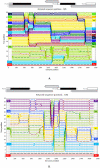Species association of hepatitis B virus (HBV) in non-human apes; evidence for recombination between gorilla and chimpanzee variants
- PMID: 22432021
- PMCID: PMC3303819
- DOI: 10.1371/journal.pone.0033430
Species association of hepatitis B virus (HBV) in non-human apes; evidence for recombination between gorilla and chimpanzee variants
Abstract
Hepatitis B virus (HBV) infections are widely distributed in humans, infecting approximately one third of the world's population. HBV variants have also been detected and genetically characterised from Old World apes; Gorilla gorilla (gorilla), Pan troglodytes (chimpanzee), Pongo pygmaeus (orang-utan), Nomascus nastusus and Hylobates pileatus (gibbons) and from the New World monkey, Lagothrix lagotricha (woolly monkey). To investigate species-specificity and potential for cross species transmission of HBV between sympatric species of apes (such as gorillas and chimpanzees in Central Africa) or between humans and chimpanzees or gorillas, variants of HBV infecting captive wild-born non-human primates were genetically characterised. 9 of 62 chimpanzees (11.3%) and two from 11 gorillas (18%) were HBV-infected (15% combined frequency), while other Old world monkey species were negative. Complete genome sequences were obtained from six of the infected chimpanzee and both gorillas; those from P. t .ellioti grouped with previously characterised variants from this subspecies. However, variants recovered from P. t. troglodytes HBV variants also grouped within this clade, indicative of transmission between sub-species, forming a paraphyletic clade. The two gorilla viruses were phylogenetically distinct from chimpanzee and human variants although one showed evidence for a recombination event with a P.t.e.-derived HBV variant in the partial X and core gene region. Both of these observations provide evidence for circulation of HBV between different species and sub-species of non-human primates, a conclusion that differs from the hypothesis if of strict host specificity of HBV genotypes.
Conflict of interest statement
Figures



References
-
- Bowyer SM, Sim JG. Relationships within and between genotypes of hepatitis B virus at points across the genome: footprints of recombination in certain isolates. J Gen Virol. 2000;81:379–392. - PubMed
-
- Dumpis U, Holmes EC, Mendy M, Hill A, Thursz M, et al. Transmission of hepatitis B virus infection in Gambian families revealed by phylogenetic analysis. J Hepatol. 2001;35:99–104. - PubMed
-
- Tatematsu K, Tanaka Y, Kurbanov F, Sugauchi F, Mano S, et al. A Genetic Variant of Hepatitis B Virus Divergent from Known Human and Ape Genotypes Isolated from a Japanese Patient and Provisionally Assigned to New Genotype J A Genetic Variant of Hepatitis B Virus Divergent from Known Human and Ape Genotypes Isolated from a Japanese Patient and Provisionally Assigned to New Genotype. J Virol. 2009;83:10538–10547. - PMC - PubMed
Publication types
MeSH terms
Grants and funding
LinkOut - more resources
Full Text Sources

